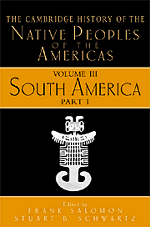Book contents
- Frontmatter
- Contents
- List of Illustrations
- Introduction
- 1 Testimonies: The Making and Reading of Native South American Historical Sources
- 2 Ethnography in South America: The First Two Hundred Years
- 3 The Earliest South American Lifeways
- 4 The Maritime, Highland, Forest Dynamic and the Origins of Complex Culture
- 5 The Evolution of Andean Diversity: Regional Formations (500 B.C.E.–C.E. 600)
- 6 Andean Urbanism and Statecraft (c.E. 550–1450)
- 7 Chiefdoms: The Prevalence and Persistence of “Señoríos Naturales” 1400 to European Conquest
- 8 Archaeology of the Caribbean Region
- 9 Prehistory of the Southern Cone
- 10 The Fourfold Domain: Inka Power and Its Social Foundations
- 11 The Crises and Transformations of Invaded Societies: The Caribbean (1492–1580)
- 12 The Crises and Transformations of Invaded Societies: Andean Area (1500–1580)
- 13 The Crises and Transformations of Invaded Societies: Coastal Brazil in the Sixteenth Century
- Index
3 - The Earliest South American Lifeways
Published online by Cambridge University Press: 28 March 2008
- Frontmatter
- Contents
- List of Illustrations
- Introduction
- 1 Testimonies: The Making and Reading of Native South American Historical Sources
- 2 Ethnography in South America: The First Two Hundred Years
- 3 The Earliest South American Lifeways
- 4 The Maritime, Highland, Forest Dynamic and the Origins of Complex Culture
- 5 The Evolution of Andean Diversity: Regional Formations (500 B.C.E.–C.E. 600)
- 6 Andean Urbanism and Statecraft (c.E. 550–1450)
- 7 Chiefdoms: The Prevalence and Persistence of “Señoríos Naturales” 1400 to European Conquest
- 8 Archaeology of the Caribbean Region
- 9 Prehistory of the Southern Cone
- 10 The Fourfold Domain: Inka Power and Its Social Foundations
- 11 The Crises and Transformations of Invaded Societies: The Caribbean (1492–1580)
- 12 The Crises and Transformations of Invaded Societies: Andean Area (1500–1580)
- 13 The Crises and Transformations of Invaded Societies: Coastal Brazil in the Sixteenth Century
- Index
Summary
INTRODUCTION
South America was the last of the continents to be discovered, invaded, and permanently settled by our species. It was a pristine land; thus the tale of settlement, as known through archaeology, has great potential both romantically and scientifically. However, in reaction to the excesses of European prehistory, in which migration and invasion were apparent at nearly every major cultural juncture, American archaeologists generally have eschewed migration as an explanatory mechanism and even failed to recognize it in the archaeological record. In the first case, the initial settlement of the Americas, obviously migration must be considered. Human radiation or migration was part and parcel of the exchange of Old and New World faunas – predominantly west to east – that took place between the Eurasian and North American Arctic in Cenozoic times (66 million years B.P. to present). During the last part of Cenozoic times, the Quaternary Period (2 million B.P. to present), when there was a Beringian land connection only part of the time, radiation and exchange took place among proboscideans (the order containing mammoths, etc.), horses, camels, mountain-sheep and goats, musk oxen, bison, moose, elk bears, foxes, wolves, and finally the predator that most concerns us – the members of our own species who had managed to adapt to the “mammoth steppe,” to prey upon the Palearctic (and eventually Nearctic) fauna.
Archaeological evidence for Amerindian ancestors’ migration through the Arctic is sketchy. There is still argument over the details of chronology and route, but it is clear that the human career in America is an extension of Eurasian Upper Paleolithic lifeways. From the beginning, the favored route has been an inland passage through Siberia, Alaska (either the Yukon Valley or the northern slopes of the Brooks Range), up the Canadian Firth and Mackenzie drainages, and finally, between the Keewatin-Laurentide and Cordilleran glacial lobes, into the North American heartland. Some have taken minority positions favoring maritime/ coastal entries across the North Atlantic or the North Pacific glaciated shores, but these have found scant support. The similarities are striking between Paleoindian (American) and Upper Paleolithic (Eurasian) hunting and gathering adaptations, migratory behavior, and artifacts.
- Type
- Chapter
- Information
- The Cambridge History of the Native Peoples of the Americas , pp. 188 - 263Publisher: Cambridge University PressPrint publication year: 1999
- 1
- Cited by



